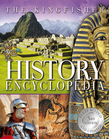“Encyclopedia” is a misnomer for The Kingfisher History Encyclopedia since it is arranged in chronological rather than topical order. Beginning with pre-history, it presents a new topic for every two-page spread. While students might read it through cover to cover, I suspect that it will more likely be used as a reference volume as you try to correlate events and find information about particular people or events.
The Kingfisher History Encyclopedia is likely best for grades four through six, but you might also use it up through about eighth grade.
This book aims for a multicultural presentation, covering Asia, Africa, India, the early Americas, and other civilizations much more than we find in typical textbooks. Timelines running across the top of the pages help students place people and events in perspective. Numerous sidebars and illustrations with their captions are also instructive. Full-color illustrations take up half of each page on average. Consequently, coverage is very selective and cursory because of the limited amount of textual material. For example, the Vietnam War is covered in a two brief paragraphs. Nevertheless, this is a good resource for obtaining a “snapshot” understanding of people, places, and events. Also, because the layout is so attractive, students are likely to browse through it on their own.
The book is divided into ten sections, each of which opens with a “World at a Glance” overview and ends with general presentations on “The Arts,” “Architecture,” and “Science and Technology.” Each of these sections covers a particular span of years while featuring pivotal events and developments from around the world. This 2012 edition concludes with a one-page summary of the war on terror that takes us up through 2011.
The pre-history section presents hypothetical information as fact, so you might want to caution children about this. Also, Christianity is treated as just one of many religions.
A “Ready Reference” section at the back lists rulers, dynasties, popes, presidents, and other chronological lists of those in power through history. An index makes it easy to look things up.
The Kingfisher History Encyclopedia is used as a "spine" book by some publishers. It works well in that role, especially alongside real books, since it helps students quickly get a sense of the big picture of what is happening around the world in various eras.









